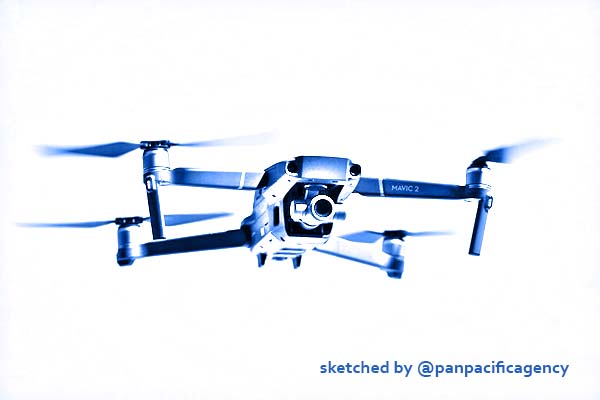US space agency lands first-ever drone on Mars

A DJI Mavic 2 Zoom drone. Photographer: Mark Kauzlarich/Bloomberg. Sketched by the Pan Pacific Agency.
WASHINGTON D.C., Feb 19, 2021, DW. It may be last but by no means least — NASA’s Mars 2020 is the third mission to have successfully arrived at the Red Planet in the space of 10 days. It’s the USA’s largest Mars rover and it’s carrying the first-ever Mars helicopter, DW reported.
The “show,” as NASA put it, started late morning Pacific Time (early evening in Central Europe). But it was another two hours before the USA’s latest rover, Perseverance, touched down on the surface of Mars at 20:56 UTC.
I’m safe on Mars. Perseverance will get you anywhere.
— NASA's Perseverance Mars Rover (@NASAPersevere) February 18, 2021
To land on Mars, the rover started its descent at a speed of over 20,000 kilometers per hour (12,000 miles per hour). A parachute and a powered descent mechanism then slowed the rover to about 3 km/h before a large sky crane lowered it on three bridle cords down to the surface of the planet, touching down on its six wheels.
As planned, Perseverance landed at Jezero Crater, just north of the Martian equator, in a region called Isidis Planitia.
It’s a region well-traveled by American landers, including the Curiosity rover, which is still active. But Curiosity is about 3,700 kilometers (2,300 miles) away at Gale Crater.
Utopia Planitia is also not too far away, relatively speaking. That’s where China intends to land its first Mars rover in May.
Three missions
Three Mars missions launched in July 2020. Aside from NASA’s Mars 2020, there is the Emirates Mars Mission and China’s Tianwen-1.
The UAE and Chinese missions are centered around spacecraft orbiting the Red Planet. But as mentioned above, Tianwen-1 will also attempt to land a rover on Mars later this year.
By far the more experienced Mars explorer is the USA. And they have gone straight for the jugular, and that with an added bonus.
First, it’s landed Perseverance, NASA’s largest-ever Mars rover. The rover will search for water and other signs of life below the surface of the planet.
For future missions
It will also collect rock and soil samples and deposit them in canisters, which — it is planned — will be collected by joint US and European missions and brought back to Earth within the next 10 years.
Illustration of the Mars rover Perseverance drilling for rock samples
The Perseverance rover drilling for rock: It’s the first step in USA/European missions to bring Martian samples back to Earth
Then, there’s that helicopter, Ingenuity, strapped to the belly of the rover.
The helicopter is an experimental device that NASA wants to use to learn about taking off and flying in the Martian atmosphere. That’s significant because the atmosphere there is far thinner than that on Earth, and that can affect flight — the amount of power and lift you need, and the speed at which the helicopter blades rotate.
Whether it works or not is almost irrelevant at this stage, because no matter what happens, it will be the first time any spacefaring nation will have tested flight “on another world,” as the American space agency has described it.
Beyond that, those test flights will potentially pave the way for future missions with astronauts going to Mars and coming back, even if that’s in 30 years’ time.
The Mars helicopter is more like a drone, but it’s hoped it will deliver valuable knowledge about flying on another world
Collaborating endeavors
The Emirates Mars Mission involves a satellite called Hope. It was the first of these three missions to successfully arrive at Mars when it entered the planet’s orbit on February 9, 2021.
It will spend two years running tests at various altitudes and aims to provide the global science community with the first complete picture of the Martian atmosphere.
It’s also pegged to the UAE’s ambition of moving away from a hydrocarbon economy towards a knowledge-based economy. It’s formed a number of international collaborations with universities in the USA and elsewhere to help it do that.
On February 10, 2021, the Tianwen-1 orbiter entered its orbit of Mars. The Chinese orbiter will also investigate the Martian atmosphere. And in three months, it is scheduled to land China’s first rover on the planet as well.
As with NASA’s Perseverance rover, China will be searching for signs of life on Mars, including water below the surface of the planet.
Competing for the stars
A number of countries and organizations have expressed an interest in working with China on its space exploration missions.
Some sources have suggested, however, that if any fears of a new space race were justified, China would be one of the main competitors — possibly with the rest of the world on the other side.
One reason for that particular suspicion is that while the USA and Europe are collaborating on a new “Artemis” moon program, which includes ground and orbiting bases, China looks set to establish its own bases in space.
But that is a very closed view. There are many other countries in the space community, including India and Israel, and most recently even Turkey has announced a new space program.
Most experts view any success in space as a success for all humankind, no matter how the knowledge and spoils are shared.
NASA points out that only about 40% of the missions ever sent to Mars — by any space agency — have been successful. So, every attempt can be applauded, if it’s done for the right reasons and where the money is not better spent elsewhere. It’s perhaps telling that even with the USA’s track record in space, Perseverance is only the fifth NASA rover to have attempted — and now succeeded — to land on Mars.